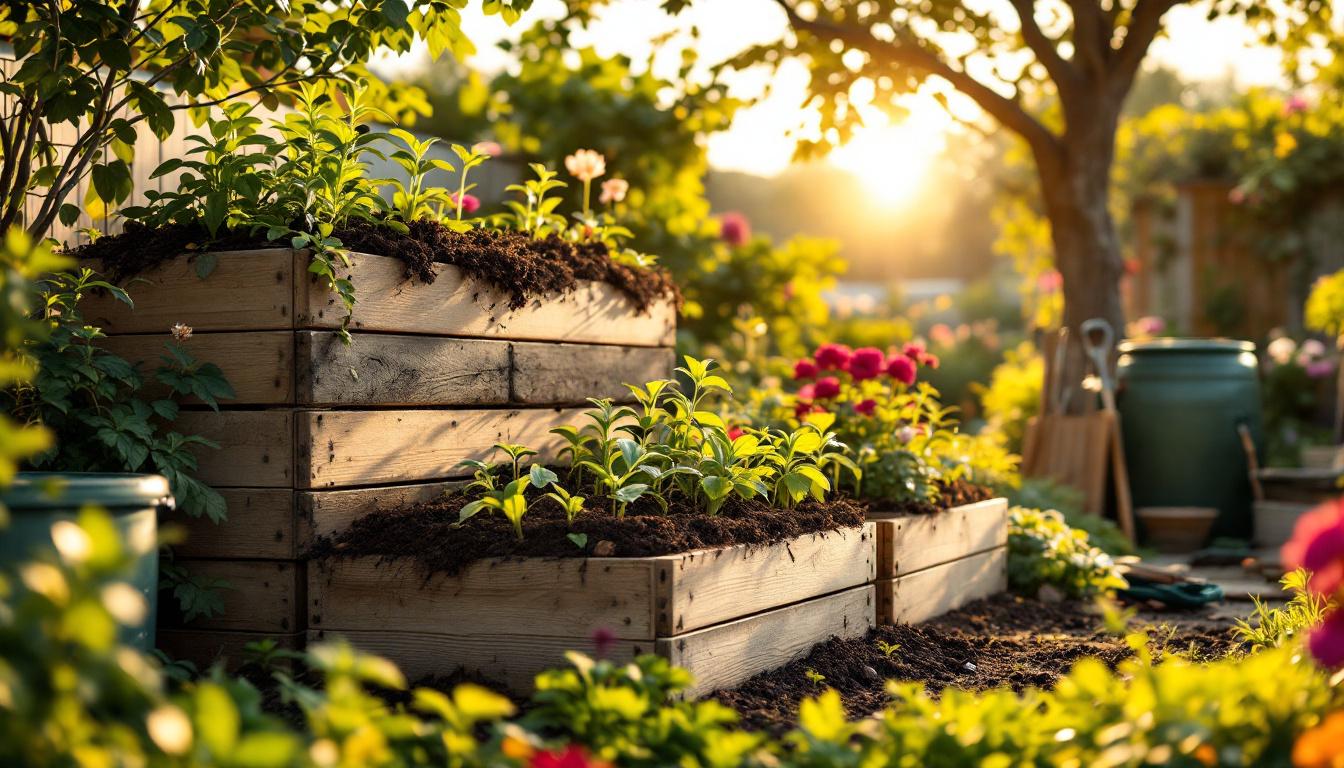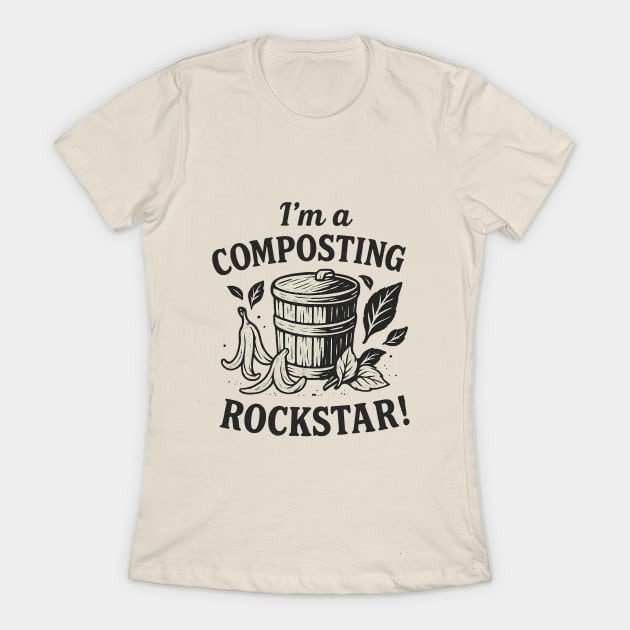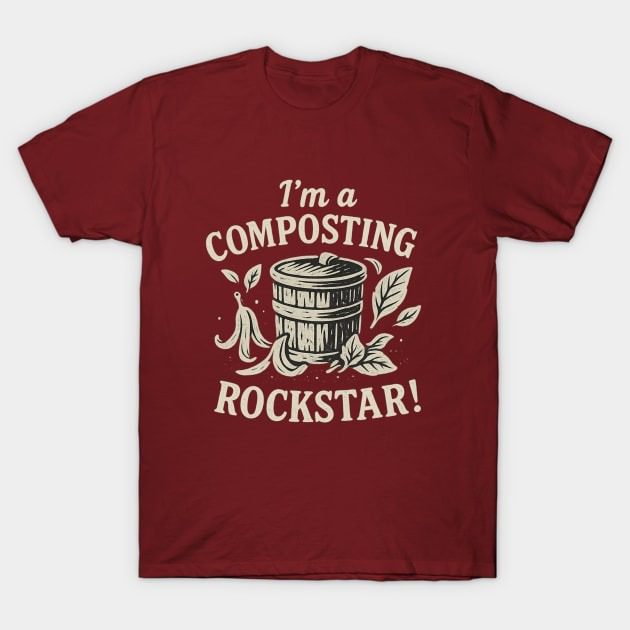Simple Tools and Tips for Easy Composting
Making compost at home is easier and cleaner than you might think.
Composting is simply turning food scraps, garden clippings, and even paper into rich, crumbly soil that feeds your plants and helps our planet.
Low effort compost systems offer an easy way for anyone to join in, whether you live in a flat, have a backyard, or just want less hassle.
You don’t need to be a garden whiz—just a willingness to recycle your leftovers and help your garden or pots grow.
A low effort compost system is all about keeping the process simple and stress-free. With options like vermicomposting (using worms), a quick-flip compost tumbler, or even smart layering in your compost bin, you can save time and skip the mess.
Composting matters because it cuts down on landfill waste, lowers your carbon footprint, and creates healthy soil right in your own space.
Anyone can do it—even kids.
You’ll learn what composting is, why it matters for your home and the environment, and which tools and methods really are the least work for the best results.
We’ll cover compost basics, how a compost tumbler can speed things up, and why a worm bin means almost no maintenance.
Plus, you’ll find links to practical guides, like the Home Vermicomposting Guide, so you never get stuck.
Key Takeaways:
- Composting is easy and good for the earth.
- Low effort compost systems save time and energy.
- Vermicomposting and compost tumblers are two simple options.
- Compost cuts waste and helps create better soil.
- Every bit of composting helps—even if you just start small.
Low Effort Composting: What Makes a System Easy?
Getting started with low effort compost systems is a breath of fresh air for anyone who wants less hassle and more healthy soil.
These setups are designed to run smoothly with little day-to-day fuss.
Whether you’re new to the process or just want to try something easier, choosing the right system and using a few key tricks can keep your compost healthy with nearly zero stress.
Minimal Upkeep, Maximum Results: Key Benefits of Low Effort Compost Systems
Low effort compost systems can be as refreshing as setting a slow cooker and walking away. You load them, give a quick spin now and then, and let the magic happen.
Here’s how these systems help busy people and composting beginners:
- Time-saving: You don’t have to turn piles with a pitchfork or monitor every handful of scraps.
- Tidier and less messy: Most systems are contained, so you skip the “ick” factor and handle less smelly, gooey waste.
- Handles odors: Sealed or managed bins keep compost smells locked inside, so your yard or kitchen stays fresh.
- Simple to use: Mix your kitchen scraps, garden trimmings or a bit of paper, and let the compost tumbler or worm bin do the heavy lifting.
Imagine dropping veggie scraps in a tumbler like dropping dirty clothes in a washing machine.
Give it a quick spin, walk away, and return a few weeks later to rich compost, no shovels required.
Even kids can easily help feed a worm bin (vermicomposting), which is like taking care of a low-maintenance pet.
These kinds of systems make composting doable for everyone, from plant-loving grannies to city flat dwellers with no time to spare.
Essential Tech and Tools for Easy Composting at Home
Low effort composting is made simple by smart tools that take the manual work off your plate. Among the favorites:
- Compost tumblers: These big, barrel-like devices are built to spin. You fill them with layers of scraps and browns, turn the handle every few days, and let them aerate everything for you. No heavy lifting, no pitchforks.
- Worm bins (vermicomposting): Small, stackable trays or bins house wriggling worms that feast on your food waste. The worms speed up the process, and harvesting their castings (which are great for plants) is as simple as pulling out a tray.
- Pre-built containers: These come with vents or drainage, so your compost stays aerobic (needs air) and you avoid gross, soggy slop.
A compost tumbler slashes the time and energy it takes to get crumbly soil, while pre-built bins can fit into small gardens or even under the kitchen sink.
The best part? Kids, adults, and even grandparents can get great results without breaking a sweat. Innovations like odor filters and automatic mixing arms are becoming more common, making things even easier for everyone.
If you’re curious about hands-on reviews and comparison guides, check out The 9 Best Composters of 2025 Tested and Reviewed for detailed insights on which low effort compost systems might be ideal for your space.
For those who prefer step-by-step assistance, the Starting Composting at Home guide covers practical ways to set up your system—perfect for first-timers and seasoned recyclers alike.
Compost Layering Technique for Low Maintenance Success
The compost layering method is perfect for anyone who wants minimal hands-on time but healthy, earthy compost at the end.
Layering is simple: by stacking different ingredients like browns (shredded paper, dry leaves) and greens (kitchen vegetable scraps), you set up a recipe that nearly takes care of itself.
Here’s why layering works so well for low effort compost systems:
- Balanced nutrition: Alternating layers mean worms and microbes always have something yummy to eat.
- Stick-free piles: Proper layering avoids compacted, stinky messes that attract flies or create slimy puddles.
- No constant turning: Setting up layers right from the start keeps your bin aerated and reduces the need for frequent mixing.
A simple formula to remember for every batch: add a layer of green scraps, cover with twice as much brown, and finish with a sprinkle of water if dry.
Repeat this pattern whenever you add new waste.
If you want your pile to truly run on self-drive, learn more about the Compost Layering Technique and set your system up for success with less guesswork.
Key Takeaways:
- Low effort compost systems save time and avoid mess.
- Compost tumblers, worm bins, and pre-built containers do the hard work for you.
- Simple layering means less turning and healthier compost.
- Even kids and beginners can succeed with these easy methods.
- For more practical advice, explore 6 Effective Composting Methods for every lifestyle.
Want an ultra-simple guide to composting that skips the confusion?
The Easy Steps to Composting Affordably article offers ideas and tips that put composting firmly within reach, no matter how busy life gets.
How to Start Your Own Low Effort Compost System
Ready to turn kitchen scraps into plant superfood without breaking a sweat? Low effort compost systems make it easy for anyone to recycle food waste and garden clippings into rich, dark compost.
Whether you want to try a compost tumbler, invite worms into your home, or just set up a simple bin, you can start small and still see big results.
With a little planning and smart choices, composting can be nearly as easy as tossing out the rubbish—but with much better rewards for your plants and the planet.
Picking the Best Method: Tumblers, Vermicomposting, or Static Bins?
 Photo by Thirdman
Photo by Thirdman
Low effort compost systems come in all shapes and sizes. The best method depends on your lifestyle, space, and how hands-off you want to be. Let’s look at three popular options:
- Compost Tumblers:
- Pros: Easy to use, keeps compost contained, fast results, less mess or smell, safe from pests.
- Cons: Larger models may take up more space, may require a quick spin every few days.
- Vermicomposting (Worm Bins):
- Pros: Perfect for small spaces and flats, smooth operation with little smell, produces compost and worm tea (liquid gold for plants!).
- Cons: Worms need to avoid extreme heat or cold, some people find the idea of worms unappealing.
- Static (Regular or Closed) Bins:
- Pros: Simple, low-cost, and can handle yard waste, kitchen scraps, and even shredded paper.
- Cons: Can be slow, may need turning or layering, risk of unpleasant odor if not balanced.
Want to dig deeper into each method? Explore step-by-step tips for every type of compost system with the 6 Effective Composting Methods guide.
The Right Ingredients: What to Compost (And What to Avoid)
For the easiest composting, use ingredients most likely already found in your kitchen or garden. When in doubt, stick to plant-based scraps and avoid anything that might attract pests or make a stink.
Easy-to-compost household items:
- Fruit and veg peelings
- Coffee grounds and tea bags (check for plastic in tea bags first!)
- Crushed eggshells
- Paper towels, napkins, and newspaper (uncoated)
- Dry leaves, grass clippings, and small twigs
- Shredded cardboard and paper
Skip or avoid:
- Meat, dairy, and oily foods (these smell and attract pests)
- Diseased plants or weed seeds
- Pet waste
- Glossy paper or anything plastic-lined
Unique tip: Save brown paper bags or pizza boxes, rip them into small bits, and mix them in as browns (carbon).
A balance of “greens” (wet stuff like peels) and “browns” (dry, papery items) makes your compost happy and stink-free.
Need more ideas on what not to toss in the bin? Check out creative ingredient lists and quirky tips in the Don’t Toss It Campaign’s Waste Not: Compost Ideas.
Maintaining Minimal Effort: Monitoring and Troubleshooting Tips
A low effort compost system shouldn’t keep you up at night.
Here’s how to keep things humming with as little work as possible.
Moisture: Your pile should feel like a wrung-out sponge. Too dry? Add kitchen scraps or sprinkle water. Too soggy? Toss in dry leaves or shredded newspaper.
Aeration: Give your tumbler a spin or poke holes in your static bin with a stick every couple of weeks. Worm bins don’t need stirring, the worms mix it for you!
Pest Patrol: If you see bugs or smell something nasty, it’s usually a sign your balance is off. Bury fresh scraps under browns, always keep the lid closed, and avoid meat or dairy.
Sometimes, composting can feel a little like caring for a pet goldfish—too much food and things get cloudy, too little water and nothing happens.
If something smells off, just adjust the greens and browns or give a quick stir. Don’t fret—a happy compost bin rarely goes bad!
For more help, ask questions anytime with the AI-powered Composting FAQ Bot, which offers quick answers when you’re stumped by a compost problem.
Key Takeaways:
- Low effort compost systems save time and are easy for beginners.
- Tumblers, worm bins, and closed bins each suit different needs and spaces.
- The right mix of compost ingredients avoids smells and mess.
- A few simple checks keep your system on track with minimal work.
- There are creative ways to compost almost anything—within reason!
- When in doubt, helpful guides and resources are just a click away.
Extra Help and Inspiration for Effortless Composting
Sometimes low effort compost systems can feel even simpler with a little help and a fresh dose of ideas.
Whether you’re looking for ways to stay motivated or need quick answers to common compost challenges, there’s no shortage of resources and community wisdom.
In this section, you’ll find recommended sources of inspiration, troubleshooting support, and ways to spark creativity with your composting—no matter your space, experience, or compost system.
Inspiration That Sparks New Habits
 Photo by Thirdman
Photo by Thirdman
Need a little nudge to keep composting when life gets busy? You’re not alone.
Many people find extra motivation by seeing what others are doing or by learning something new. Here’s how to fuel your composting journey:
- Join a compost group online or locally. Sharing tips, celebrating your first “black gold” harvest, or even swapping composting stories keeps things light and fun.
- Read success stories. See how neighbors handle garden or kitchen scraps with their own low effort compost systems. If you have limited space, try these small garden composting tips for inspiration.
- Experiment with new systems. Maybe you’re happy with your compost tumbler, but curious about bokashi or worm bins. Trying a new method could bring a fresh energy to your routine. For a different approach, discover options like top bokashi compost bins for beginners.
Staying inspired often means making composting a habit, not a chore.
Set a reminder, track your food waste for a week, or make composting a family project to keep things exciting.
Quick-Access Support and Troubleshooting
Even the best low effort compost systems sometimes hit a snag. Maybe your pile smells funny, or worms seem sluggish.
Fast answers make things easy and keep your system humming.
- AI-powered FAQ bots: Get instant advice tailored to your situation. The Composting FAQ Bot can tackle everything from odor issues to what’s safe to add to your bin.
- Seasonal checklists: Composting changes with the weather. Don’t let cold or damp weather disrupt your worm bin—take a look at tips for winter composting challenges with worms to keep things on track.
- Community forums: Many gardeners love to share quick solutions for common questions, and chances are, someone else has solved the same hiccup.
If you’re stuck, pause for a moment and double-check your greens (wet stuff) and browns (dry stuff) mix.
Often a little stir or a handful of leaves does the trick.
Get This Great Design On Shirts, Mugs, Bags..HERE
Creative Composting Ideas to Keep It Fun
Low effort compost systems shine when you add a dash of creativity.
Composting can be more than throwing scraps in a bin—it can be hands-on science, a way to teach kids, or part of living with less waste.
Consider fun ways to get even more out of your setup:
- Start a composting calendar. This helps track what you add and spot patterns in what works best through the seasons.
- Try a worm observation jar. If you use vermicomposting, kids can watch worms turn scraps into soil through a clear jar—bonus, it’s less smelly than a frog habitat.
- Decorate your bin. Add some color or a funny sign to make the area more cheerful and welcoming.
- Challenge your household. Set a “no food waste” week and see how much you can compost compared to your usual rubbish.
Look for unique ways to reuse compost in your garden, from planting wildflowers in finished compost to making “compost tea” for houseplants.
Key Takeaways
- Extra help is everywhere, from online groups to smart AI-powered bots.
- Low effort compost systems stay easy with the right inspiration and troubleshooting tools.
- Small changes like a composting calendar or a decorated bin keep things interesting.
- Engaging family or roommates makes composting a friendly routine, not a fuss.
- Don’t be afraid to ask for advice or try something new—it keeps the process fresh and fun.
If you want even more ideas or detailed guidance on all things worm bins, see the collection of vermicomposting tips and techniques for every experience level.
Whether you need a spark of encouragement or a quick fix, you’re in good company.
Composting can be as creative, collaborative, or effortless as you want it to be—just keep it fun and low-key.
Conclusion
Low effort compost systems make it easy to turn kitchen scraps and garden clippings into nutrient-rich compost with just a few minutes of care each week.
Whether you choose a compost tumbler for speedy results or vermicomposting for a worm-powered, low-maintenance setup, these solutions keep things clean, quick, and stress-free.
Anyone can create healthier soil and shrink household waste with basic tools and a simple routine.
There’s no need to fear messes or complicated steps. Families, kids, and even busy city-dwellers can all enjoy composting success, especially when you use the Compost Tumbler or creative methods from trusted sources.
If your compost ever needs a boost, tips on fixing slow compost tumblers can get things back on track.
Every bit of composting helps the planet and your garden’s health.
Try starting a bin, let the worms or tumbler do the hard work, and see for yourself how easy and rewarding it can be.
Key Takeaways
- Low effort compost systems save time, reduce hassle, and work in small or large spaces.
- Composting with tumblers or vermicomposting turns food waste into valuable soil with minimal input.
- Smart layering and simple maintenance keep compost piles healthy and free from odors.
- Resources and troubleshooting guides are always available for any composting challenge.
Get This Great Design On Shirts, Mugs, Bags..HERE
Quick FAQ
What is composting?
Composting is the natural process of breaking down food scraps, garden waste, and paper into a dark, crumbly material that helps plants grow.
It recycles your leftovers into valuable compost for your soil.
What makes a system “low effort”?
These systems do most of the work for you. Compost tumblers and worm bins need very little turning, have fewer smells, and require just a quick check or a spin now and then.
Can kids help with composting?
Absolutely! Kids can add scraps, spin the tumbler, and even look after worms. It’s a safe, hands-on way to learn about recycling and growing healthy plants.
How do I avoid bad smells?
Keep a balance of “greens” (wet scraps) and “browns” (dry materials), make sure the bin has enough air, and avoid adding meat or dairy. If something smells off, mix in more dry stuff or give it a quick stir.
Where can I get more help?
For step-by-step advice, visit the How To Start Composting guide or ask questions anytime with the AI-powered Composting FAQ Bot.
Thank you for joining the composting journey! Every small step makes your home greener and the planet healthier.
Give composting a try and explore Compost Charm for more tips, ideas, and friendly support.






